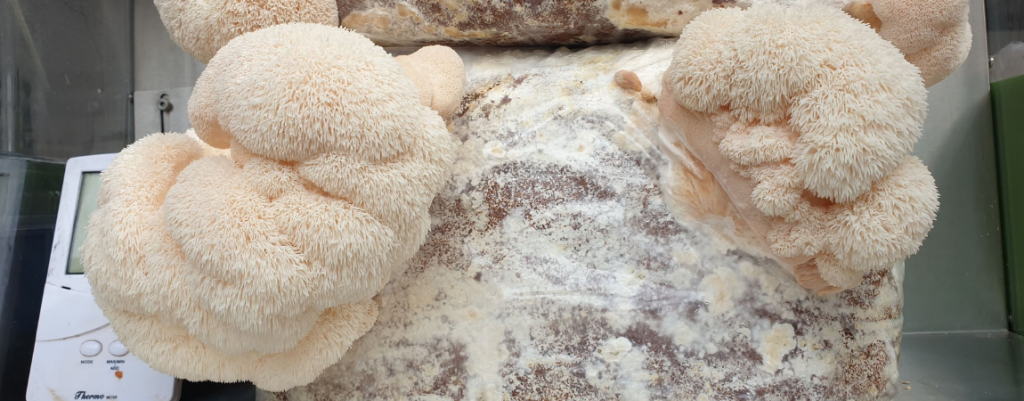Interested in growing lion’s mane mushrooms? These unique mushrooms are delicious and nutritious, with a lot of potential health benefits.
In this article we’ll show you how to grow Lion’s Mane mushrooms at home indoors on sawdust blocks or outdoors on logs. We’ll also share some tips on when and how to harvest and discuss the health benefits of this amazing mushroom too.
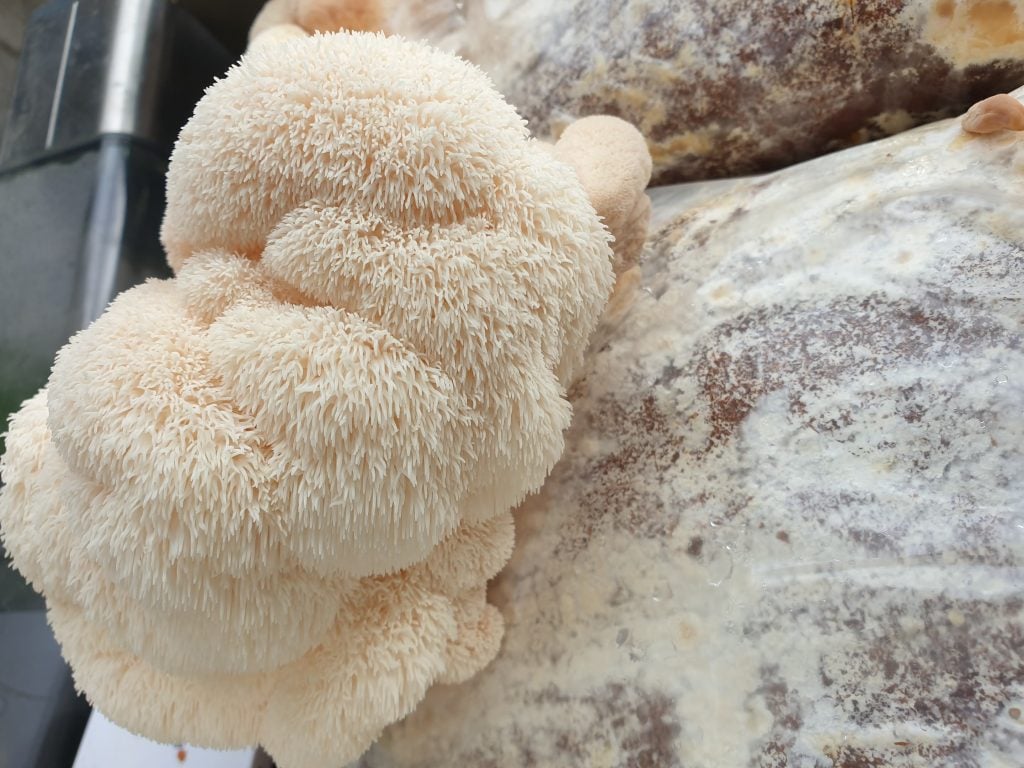
What Is Lion’s Mane Mushroom?
Lion’s mane mushroom (also known as the pom pom blanc, monkey’s head mushroom, or Hericium Erinaceus) is a large, white, pom-pom-like mushroom.
Their teeth or needles are the gills, and they cascade downwards as they grow, giving them a shaggy look, hence the name lion’s mane.
These unique-looking mushrooms are native to Asia, Europe and North America and grow on decaying hardwood trees and logs throughout the northern hemisphere.
Lion’s mane mushrooms have a soft, spongy texture and an internal structure similar to cauliflower, with branches extending from a single base.
Their mild, slightly sweet flavor is considered by many to be similar to crab or lobster. When cooked, the “teeth” create a meat-like texture, making them a delectable meat substitute in vegetarian dishes.
Lion’s mane mushrooms are not only edible, but also medicinal and provide a host of potential health benefits.
Growing Lion’s Mane Mushrooms at Home
Growing lion’s mane mushrooms at home is convenient and very rewarding. You don’t need a lot of space to grow these nutritious mushrooms, and there is no messy soil involved.
You can grow them on logs in a shady spot outdoors or indoors in a spare room or basement. If you live in a small apartment, you could grow them using a shotgun fruiting chamber.
We’ll cover how to grow Lion’s Mane mushrooms at home a bit further on in this article.
Is Lion’s Mane Easy to Grow?
Lion’s mane is relatively easy to grow, but can take a bit of learning for beginners as lion’s mane mycelium is very fine. This makes it difficult to know when the lion’s mane is fully colonised and ready for fruiting.
If you are new to mushroom growing, we suggest starting by growing oyster mushrooms to gain a bit of experience before attempting growing lion’s mane.
Or alternatively you could consider buying Lion’s Mane ready-to-fruit blocks, which come fully colonised and ready to fruit – making it super simple to get started growing your own Lion’s Mane mushrooms.
Growing Lion’s Mane Mushroom Indoors
There are several convenient ways you can go about growing lion’s mane mushroom indoors. Your level of mushroom growing experience and the number of mushrooms you would like to grow are deciding factors when choosing the best method for yourself.
Check out our in-depth video guide to growing Lions Mane Mushrooms:
If you are new to growing mushrooms, you may want to purchase a lion’s mane mushroom growing kit or ready to fruit substrate block.
These come with an inoculated and incubated substrate that is ready to start fruiting, so you can start growing your lion’s mane mushrooms as soon as you get your kit.
Another way to grow lion’s mane is by using spawn from a reputable spawn supplier and inoculating your substrate.
Or, if you are experienced and want a challenge, you could start from scratch and make your own lion’s mane grain spawn.
In the step by step guide below, we cover everything you need to know about growing lion’s mane mushrooms with spawn purchased from a spawn supplier.
Step 1: Gather Supplies
The first step in growing lion’s mane mushrooms at home is to order and gather all the equipment and supplies needed.
Materials:
- Lion’s mane spawn
- Hardwood pellets
- Oat or wheat bran
- Water
- Growing bags, buckets or containers
Equipment:
- Measuring cup
- Scale
- Bucket or bowl
- Pressure cooker
Where to Buy Wood Chips for Growing Lion’s Mane
You can often get wood chips from tree surgeons or landscaping companies for free or low cost. Ask for hardwood chips if you’re going to do this.
An easy alternative is to use wood pellets instead of wood chips. Nowadays, hardwood pellets are commonly used for pellet stoves and grills, making them readily available.
They are ideal for growing mushrooms, fairly inexpensive and easy to store. You can buy hardwood pellets at local retail stores, hardwood stores or online.
Make sure to get hardwood pellets as mushrooms don’t grow well on softwoods. All forms of hardwoods make great substrates for lion’s mane. You don’t need the pricier hardwood pellets made from hickory or apple.
Where to Buy All Other Materials
You can purchase your lion’s mane grain spawn online from a specialist spawn supplier. To find suppliers in your area, search “lion’s mane mushroom spawn + [your country]”. You can also find lion’s mane spawn on Amazon.
You can use oat or wheat bran as the nitrogen rich supplement in your substrate. Small bags are available at grocery stores. However, a less expensive option is to buy it in larger quantities from animal feed stores.
Purpose made mushroom growing bags make ideal substrate containers. They are an essential tool for growing mushrooms, professionally or as a hobby. You can find and purchase grow bags online.
Step 2 – Prepare Substrate
The goal of a substrate is to provide a hydrated, nutrient-dense food source for the mycelium. Hardwood pellets with bran are one of the best substrates for growing lion’s mane.
Hardwood pellets alone don’t need to be sterilized. The heat and pressure of the pellet production process does this. However, adding wheat or oat bran means the whole mixture needs sterilizing.
To make a five-pound block of substrate you need:
- Five cups of hardwood pellets
- One and a quarter cups of bran
- Six cups of water
Combine the pellets and water in a bucket or bowl and soak for 30 minutes. The pellets will break apart and become sawdust. Using warm water speeds up the process but is not necessary. Add the bran to the sawdust and mix until evenly distributed.
Make sure your substrate has the right moisture content. Do a squeeze test by slightly squeezing your substrate. A couple of drops of water should come out.
If too much water comes out, it’s too wet. If no water comes out and the substrate isn’t staying together in your hand, it’s too dry.
Place the mixture into a grow bag, expel as much air as possible and fold the bag according to instructions.
Now sterilize the substrate in a pressure cooker for two and a half hours at 15PSI.
Allow your substrate to cool down for at least eight hours before you move on to step three, inoculation.
Step 3: Inoculate Your Substrate
Inoculation is the process of adding your lion’s mane mushroom spawn to your prepared substrate. Before starting, wipe down all work surfaces and clean your hands well with soap to avoid contamination.
Next, you need to add your lion’s mane spawn at a 5% spawn rate to wet substrate per bag, mix them together and close the top of the bag with a rubber band or a tie of some kind.
Step 4: Incubate the Inoculated Substrate
Place the closed bag in a dark, warm area around 20 – 24°C ( 68 – 75°F) and leave it to incubate.
The lion’s mane spawn will grow, spread throughout the bag and completely colonize the substrate. It takes around two to three weeks for your lion’s mane substrate to fully colonize.
Step 5: Fruiting Lions Mane
When colonization is complete, place your substrate in these fruiting conditions:
- Temperature: 15-24C (59-75 F)
- Humidity: 85 – 90% RH
- Light: 500 – 1000 Lux
- Co2: 500 – 1000ppm
Cut two 5-10cm slits in the bag for the mushrooms to grow out of.
After 5-7 days, you’ll start to see pinheads (primordia) forming on your substrate. These will grow into full-sized mushrooms and be ready to harvest in another 5-10 days (depending on the temperature).
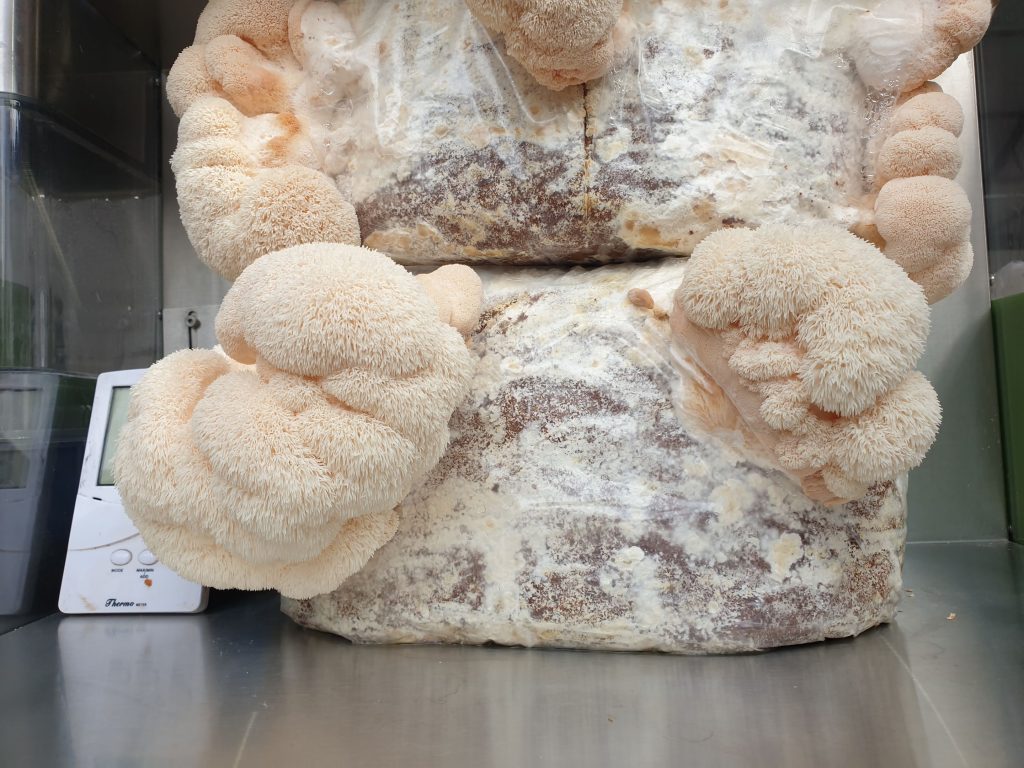
Growing Lion’s Mane on Logs
Growing lion’s mane on logs is a cost effective way to get a steady, reliable supply of fresh lion’s mane for years.
In the step by step guide below, we cover everything you need to know about growing lion’s mane on logs. See this article from our resource hub from our complete guide to growing mushrooms on logs.
Step 1: Gather Supplies
The first step in growing lion’s mane mushrooms on logs is to gather the materials and equipment needed, including finding logs and ordering spawn plugs.
Select Your Logs
The first step in gathering supplies is to find some fresh logs.
Lion’s mane grows well on various hardwoods, including beech, elm, oak, maple, and birch.
Look for healthy hardwood trees when choosing logs. Trees with decayed wood or signs of infection may contain other fungi and won’t do.
Lion’s mane mushrooms grow very large. Using logs that are 3 to 10 inches (8 to 25 cm) in diameter will give you larger mushrooms.
It is better to harvest logs from dormant trees during fall or winter as they have more concentrated sugars. Don’t wait more than a month from when your log was cut before inoculating.
If you let your logs lie around for too long, you risk other types of fungus populating the logs.
Purchase Spawn Plugs
You can purchase lion’s mane spawn plugs online. Before you do, you’ll need to calculate how many plugs you need. A four-foot log usually requires about 30 to 50 plugs for full coverage.
However, you can use this formula to figure out how many plugs you’ll need for any given log:
Number of holes = (Length of the log in cm x diameter of the log in cm) / 60
Once you have your logs and spawn plugs, gather the equipment and supplies needed for inoculation.
Materials:
- Lion’s mane spawn
- Hardwood logs
- Sealing wax
Equipment:
A drill
A hammer
A small paintbrush or baster
Check out our video about how to grow mushrooms on logs for an overview of this method:
Step 2: Inoculate Your Logs
Start by drilling a row of 1 inch (3 cm) deep holes every 6 inches (15 cm) apart down your log. Stagger your holes, starting your next row of holes about 2.5 inches (6 cm) away from your first row.
Once you have finished drilling the holes in your log, insert your plug spawn dowels into the holes. Tap the plug spawn dowels gently with a hammer to get them fully inserted. They should be below the surface of the bark and flush with the actual wood of the log.
Now you need to seal the plugged holes with wax to protect the mycelium. Cheese wax is commonly used for sealing up holes, but you can also use candle wax or beeswax. Melt your wax in a double boiler, old deep fryer or pot.
Once melted, use a wax dauber or small brush to apply the wax to your holes.
Step 3: Incubate Your Logs
During incubation, you need to store your logs in a shady place. There are several different ways you can stack them whilst incubating to ensure optimal air circulation and humidity.
You’ll need to water your logs once or twice per week for 10 minutes to maintain the appropriate level of moisture in them. If they dry out completely, your mycelium will die.
It will take one to two years after inoculating the logs before they produce their first harvest.
Step 4: Initiate Fruiting
Keep a lookout for signs of mushrooms starting to grow out of the plugged holes 12 to 18 months after inoculation.
If there are no signs of growth after 12 months you can try to initiate fruiting by shocking your logs. This involves completely submerging your logs in cold water and soaking them for 12 hours.
Spring and fall are the best time of year to shock your logs as this is when the temperatures are right for growth. Summer can be a bit hot and you don’t want to shock your logs when the temperatures drop and there is a chance of freezing.
During the fruiting phase you should mist your logs daily to keep them moist and remove any slugs.
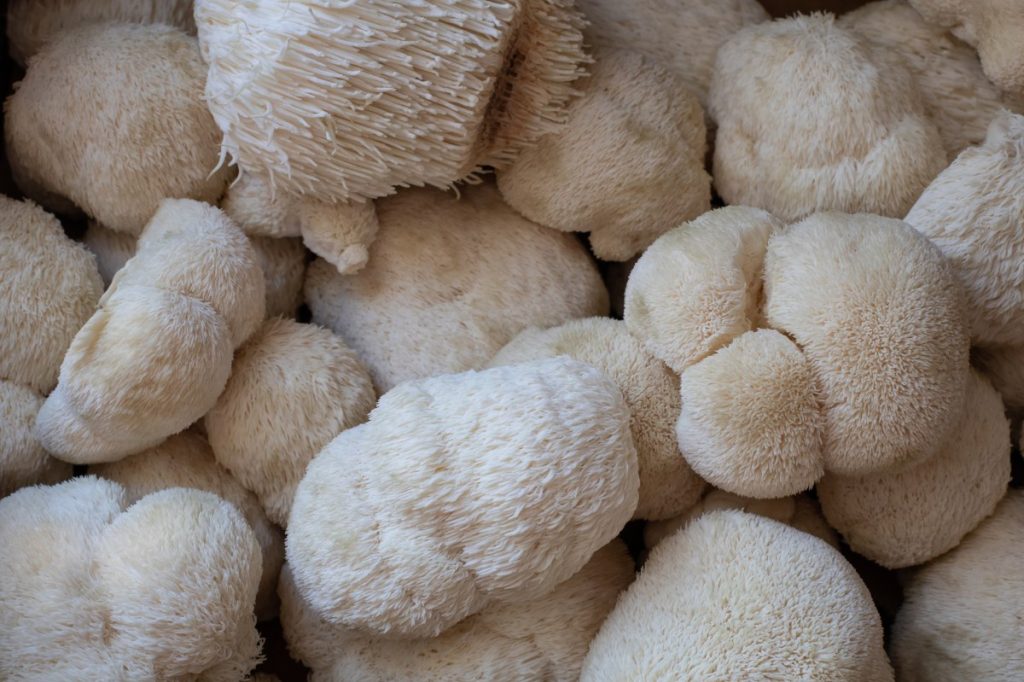
Harvest and Enjoy Your Lion’s Mane Mushrooms
Once your lion’s mane mushrooms start fruiting, it won’t be long before you can harvest and enjoy them. In as little as two weeks, you could be feasting on delicious, fresh lion’s mane mushrooms.
How Do I Know When Lion’s Mane Are Done Growing?
Lion’s mane mushrooms are done growing when they stop increasing in size and the spines grow longer and thicker.
You’ll need to harvest them before they turn yellow or brown for the best flavor and texture. Pick the lion’s mane at different stages of maturity to get different textures. Younger lion’s mane mushroom is firmer and denser.
If the fruitbodies feel like they will come off the bag easily then they are ready to harvest. If there is resistance and you feel that you would need to pull them off hard, then they are likely not quite ready yet.
How to Harvest Lion’s Mane
Harvest Lion’s Mane by cutting the “ball” off close to the base with a sharp knife, taking care not to damage the fruit. Lion’s mane will last much longer in the fridge if handled delicately to prevent bruising.
You can also twist gently with your hand to harvest Lions Mane.
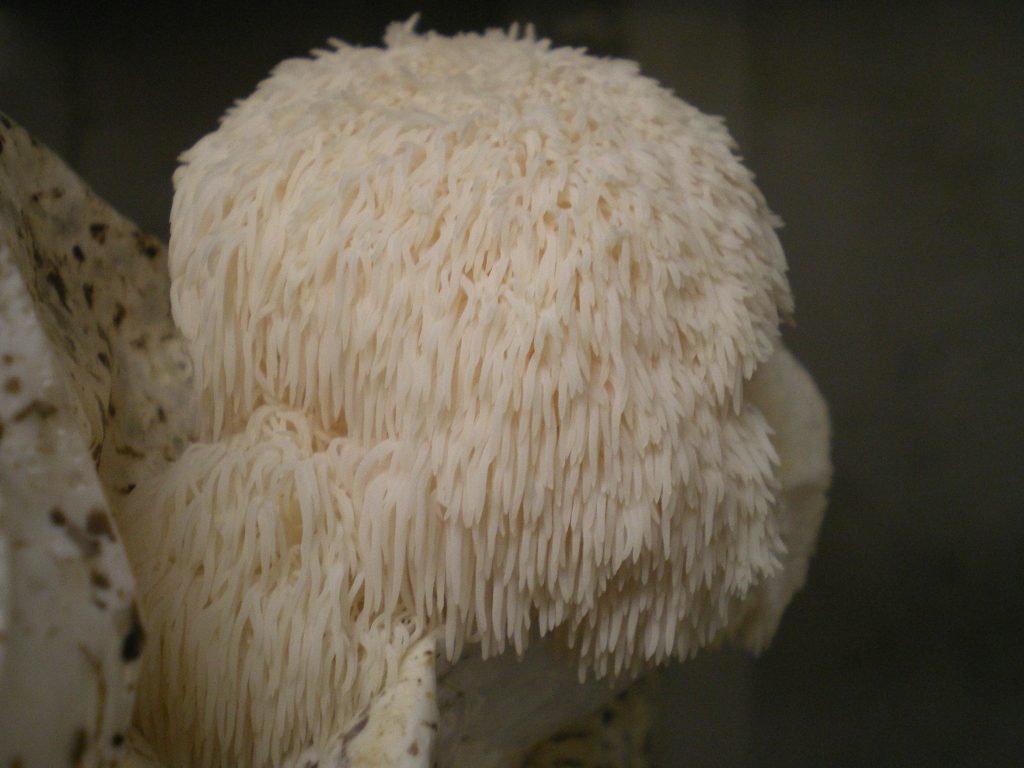
Storing Lion’s Mane
Refrigerate lion’s mane right after harvesting in a ventilated container.
Fresh lion’s mane will keep in the fridge for around a week. If you harvest more lion’s mane than you can eat in a week, store excess mushrooms by drying them out in a food dehydrator or oven.
Preparing and Cooking Lion’s Mane
Lion’s mane mushrooms are extremely versatile as the main ingredient or a delicious side dish. Their consistency and flavour make them a fabulous seafood substitute in almost any recipe.
They can be sliced into rounds or cut lengthways into long slices and pan-fried. Try chopped up lion’s mane “crab” cakes or use them in soups and sauces. Their spongy texture makes them excellent at soaking up flavours.
However you choose to cook them, lion’s mane mushrooms are a delicious, nutritious addition to any menu.
Learn more about the Health and Nutritional Benefits Of Mushrooms.
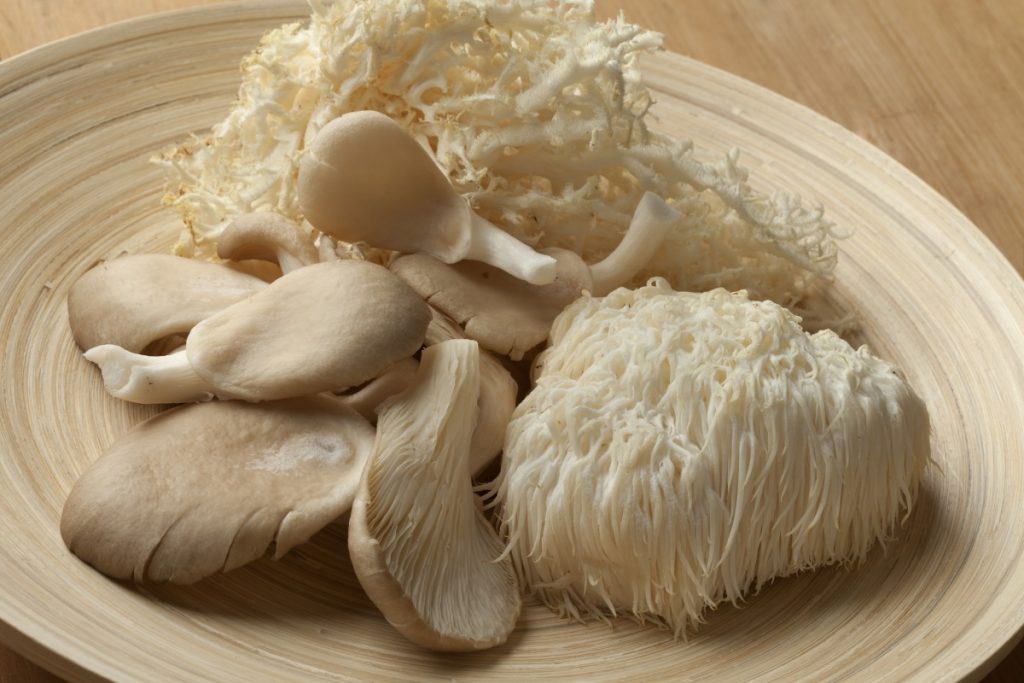
Health Benefits of Lion’s Mane
Lion’s mane mushrooms are one of the many medicinal mushrooms that have various health benefits. They contain a substance called “erinacine”, which studies have shown can improve cognitive abilities by initiating the growth and regeneration of nerves.
Research shows lion’s mane mushrooms can boost the immune system by increasing immunity in the intestinal immune system thereby protecting the body from germs that enter through the nose and mouth.
They also have anti-inflammatory properties and studies show lion’s mane helps to reduce inflammation and the symptoms of inflammatory bowel disease.
How Long Does it Take to Grow Lion’s Mane?
If you are growing lion’s mane on logs, it takes one to two years after inoculation to harvest your first batch of fresh lion’s mane. Lion’s mane is not quick-growing on logs, but once they start producing, you can harvest mushrooms off the same log for up to six years.
However, growing lion’s mane indoors in bags or containers is a lot quicker. You could be harvesting delicious lion’s mane mushrooms approximately one month after inoculating your substrate. During this time three things happen.
- A colonization stage of around 12 – 19 days, during which the mycelium spreads throughout the substrate.
- Once fully colonized and placed in the fruiting chamber, pins (the beginning stages of a mushroom) appear in 3-7 days.
- The lion’s mane keep growing and are ready to harvest in approximately 5-10 days, dependent on temperature..
Where Does Lion’s Mane Mushroom Grow?
Lion’s mane mushrooms grow well on a wide variety of hardwoods. In nature, wild lion’s mane mushrooms can be found on decaying hardwood trees throughout the northern hemisphere.
When growing lion’s mane at home, depending on where you live, you have a choice. You can grow them indoors with a hardwood substrate or outside on logs.
In the step by step guides below, we cover how to grow lion’s mane mushrooms, indoors and on logs, and what equipment you’ll need.
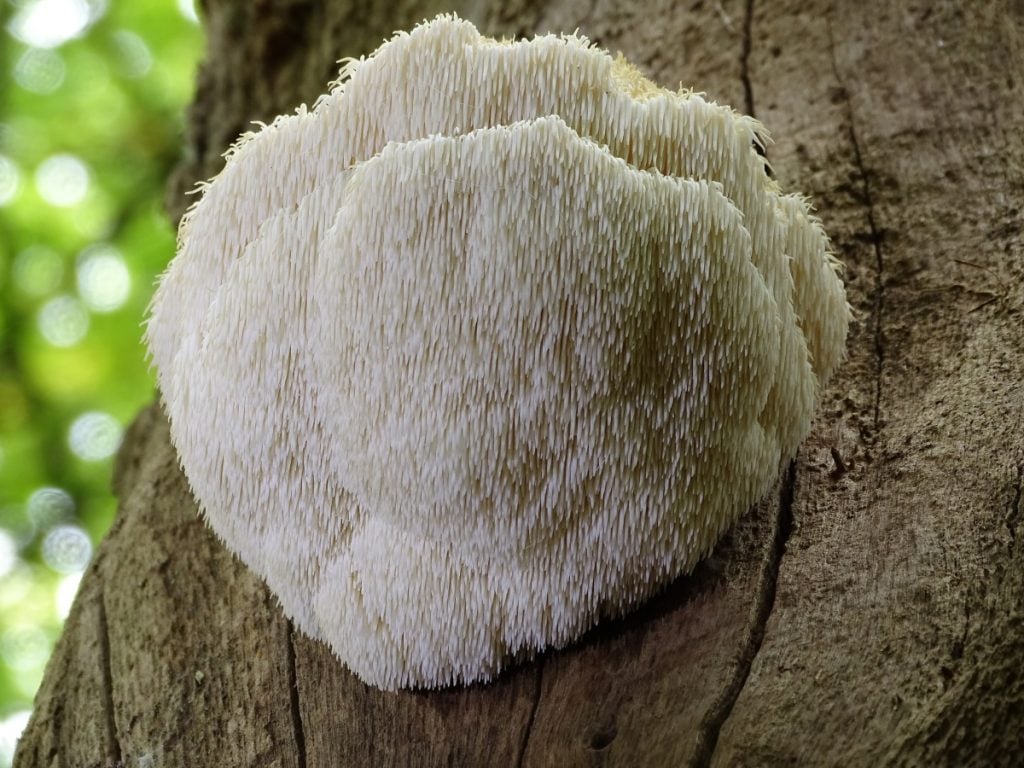
Is Lion’s Mane Illegal?
Lion’s mane is not illegal. However, this healthy culinary mushroom is relatively unknown, and you are unlikely to find fresh lion’s mane at your local grocery store.
The best way to access and enjoy delicious, fresh lion’s mane is by growing lion’s mane mushrooms at home.

Final thoughts
Lion’s mane mushrooms are not the only mushrooms you can grow at home. If you are new to mushroom growing or want to learn how to grow other types of mushrooms, visit our Mushroom Growing Resource Hub. Here you will find information and step by step guides on all aspects of mushroom growing.
